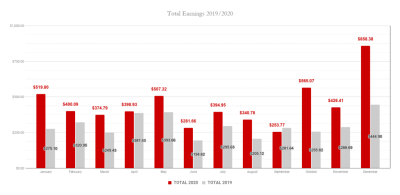Are you a photographer, designer, or artist looking to boost your earnings on Shutterstock? You’re in the right place! Shutterstock is a fantastic platform to showcase your work to a global audience, but simply uploading your images isn’t enough to maximize your income. By understanding how the system works and applying some strategic tips, you can turn your creative efforts into a steady revenue stream. In this post, we’ll explore practical strategies to help you increase your
Understanding Shutterstock’s Revenue Model

Before you can effectively increase your earnings, it’s important to understand exactly how Shutterstock’s revenue model works. Shutterstock operates on a royalty-based system that rewards contributors based on the number of images downloaded and the type of subscription or license purchased. Here’s a quick breakdown:
- Royalty Tiers: Shutterstock uses a tiered royalty system. The more downloads you accumulate, the higher your royalty rate becomes. Initially, new contributors start at a lower percentage, but as your portfolio gains popularity, you can earn up to 30% per download.
- Subscription vs. On-Demand Purchases: Shutterstock offers different purchasing options. Subscribers pay a monthly fee for a set number of downloads, which generally results in lower royalties per image. On-demand buyers purchase images individually, often leading to higher payouts for contributors.
- Download Volume and Popularity: The total number of downloads and your images’ popularity significantly impact your income. High-quality, relevant images tend to get downloaded more often, increasing your earnings.
It’s also helpful to understand that Shutterstock’s algorithms favor fresh, trending, and niche content. They prioritize images that are in demand, so regularly updating your portfolio with current and diverse images can have a positive effect on your revenue. Additionally, understanding the licensing options and how they influence your payout can help you tailor your uploads for maximum earnings.
To sum up, knowing the ins and outs of Shutterstock’s revenue model allows you to strategize better. By focusing on creating high-demand content, optimizing your keywords, and understanding how licensing affects your payout, you set yourself up for greater success. In the next sections, we’ll explore specific strategies to help you increase your earnings even further.
Optimizing Your Portfolio for Better Visibility

Alright, let’s talk about one of the most important steps to boost your earnings on Shutterstock: optimizing your portfolio. Think of your portfolio as your storefront; the more attractive and discoverable it is, the more visitors (potential buyers) you’ll attract. Here are some practical tips to make your portfolio stand out and get noticed:
Use Clear, Descriptive Titles and Tags
When uploading new images, always use specific and relevant titles. Instead of generic labels like “Nature Photo,” go for something more detailed like “Sunset Over Mountain Range with Pink and Orange Sky.” Similarly, tags are your keywords—think about what your target audience might search for. Use a mix of broad and niche tags to increase discoverability.
Organize Your Portfolio Thoughtfully
- Create Collections: Group similar images into collections or albums. This not only makes your portfolio look organized but also helps buyers find related images easily.
- Showcase Your Best Work First: Keep your top-performing or most appealing images at the front. First impressions matter!
Update Regularly and Remove Outdated Content
Keep your portfolio fresh by adding new images frequently. Remove or update images that aren’t performing well or no longer represent your style. Active portfolios tend to rank higher in search results.
Leverage Shutterstock’s Search Algorithm
Understanding how Shutterstock ranks images can give you an edge. They favor images with accurate metadata, good engagement (views, downloads), and high-quality visuals. So, focus on quality, but also on the details—your titles, tags, and descriptions matter a lot.
Engage with the Community
Comment on other photographers’ work, participate in forums, and follow popular contributors. Engagement can lead to increased visibility and even collaborations, which can open new revenue streams.
Creating High-Quality and Relevant Content
When it comes to earning more on Shutterstock, nothing beats producing high-quality, relevant content. Think of this like planting seeds—you want to plant images that will grow into sales. Here’s how to make sure your content hits the mark:
Invest in Good Equipment and Editing
Sharp, well-lit images are more appealing and professional-looking. Use a decent camera or smartphone with a good camera, and learn basic editing skills to enhance your photos. Simple adjustments like brightness, contrast, and color correction can make a big difference.
Focus on Trends and Market Demand
Stay updated with current design trends, seasonal themes, and popular niches. For example, during holidays, images related to celebrations, gifts, or winter scenes tend to sell well. Use tools like Google Trends or Shutterstock’s own trending searches to identify what buyers are looking for.
Prioritize Relevance and Authenticity
Content that resonates with real-life scenarios tends to perform better. For instance, instead of generic office photos, show diverse, authentic workplace environments. Or, if you’re photographing food, make sure it looks fresh, inviting, and relevant to current food trends.
Maintain Consistency in Style and Quality
Develop your unique style or focus area—be it vibrant landscapes, minimalist designs, or candid portraits. Consistency helps build your brand, and buyers looking for a specific aesthetic are more likely to choose your work.
Plan Your Content Strategy
Think about what kinds of images are missing or in demand. Create a content plan that includes thematic shoots, diverse subjects, and variations to appeal to different buyer needs. This proactive approach ensures your portfolio remains relevant and competitive.
In short, creating high-quality and relevant content isn’t just about artistry; it’s about understanding market needs, maintaining professionalism, and continuously refining your craft. When combined with a well-optimized portfolio, it can significantly increase your earnings on Shutterstock. Keep learning, experimenting, and staying inspired—that’s the secret to long-term success!
Utilizing Keyword Strategies for Better Search Rankings
When it comes to making your images stand out on Shutterstock, mastering the art of keywording is absolutely essential. Think of keywords as the signposts that guide buyers directly to your work. If your keywords are spot-on, your images are more likely to appear in relevant searches, increasing your chances of making a sale and boosting your earnings.
First, put yourself in the buyer’s shoes. What words would they type into the search bar when looking for an image like yours? Be as specific as possible. Instead of just “dog,” consider adding details like “golden retriever puppy playing” or “small brown dog sleeping.” The more precise your keywords, the higher the chance your image will show up for targeted searches.
Here are some practical tips for keyword optimization:
- Use relevant keywords: Focus on what truly describes your image. Avoid irrelevant or vague terms.
- Think like a buyer: Use common search phrases and synonyms that people might use.
- Include multiple keywords: Cover different aspects—colors, emotions, settings, concepts.
- Leverage trends: Incorporate trending topics or popular keywords, but only if they genuinely relate to your image.
- Stay updated: Regularly review which keywords are performing well and tweak your tags accordingly.
It’s also helpful to use a mix of broad and specific keywords. Broad keywords like “business” or “nature” can bring in a wider audience, while specific ones like “urban skyline at sunset” attract niche buyers looking for something very particular. Remember, the goal is to balance relevance with search volume to maximize visibility.
Don’t forget to fill out all available keyword slots—most platforms give you a limited number, but use every one effectively. Avoid keyword stuffing, though; focus on quality over quantity to keep your images appearing professional and relevant.
Analyzing Trends and Popular Themes
Staying ahead in the Shutterstock game means keeping a close eye on what’s trending and understanding what themes are capturing the market’s interest right now. Trends can shift quickly, especially in visual content, so being proactive can significantly increase your earnings.
Start by exploring Shutterstock’s own trending sections and popular categories. These areas showcase what buyers are currently searching for and purchasing. You can also use tools like Google Trends or social media platforms to see what topics are gaining momentum. For example, if sustainability or remote work are hot topics, creating images related to these themes might give you a competitive edge.
Another good approach is to regularly review top-selling images in your niche. Ask yourself:
- What themes do these images share?
- What colors, styles, or concepts are prevalent?
- Are there specific subjects that seem more popular now?
By analyzing these patterns, you can tailor your content to match what buyers are actively seeking. For example, if minimalist designs are trending, consider creating simple, clean images with neutral tones. If virtual meetings are popular, produce high-quality photos or illustrations that depict professional online interactions.
Additionally, keep an eye on seasonal and cultural events. Creating content themed around holidays, seasons, or current events can give you a temporary boost in visibility and sales. For example, around the New Year, images related to resolutions or celebrations tend to sell well.
Finally, embrace flexibility. Trends come and go, so diversify your portfolio with evergreen content but also experiment with timely themes. This balanced approach ensures you’re not left behind and helps you capitalize on both long-term and short-term opportunities to increase your earnings on Shutterstock.
Engaging with the Shutterstock Contributor Community
One of the most underrated ways to boost your earnings on Shutterstock is by actively engaging with the contributor community. When you connect with others who share your passion for photography or design, you gain access to a wealth of knowledge, support, and opportunities that can significantly impact your success.
Joining forums, social media groups, or even attending contributor meetups can help you stay updated on industry trends and best practices. These communities often share tips on how to improve your portfolio, what types of content are in demand, and how to optimize your keywords and descriptions for better visibility.
Beyond gaining insights, engaging with your peers can lead to collaborations, referrals, and even mentorship opportunities. For example, you might find a fellow contributor who specializes in a niche you’re interested in exploring further, and they might offer valuable advice or even partner with you on projects. Building a network also makes the experience more enjoyable and less isolating, keeping you motivated to create quality content consistently.
Furthermore, some Shutterstock forums and groups host contests or challenges that can give your work extra exposure. Participating in these can sometimes lead to featured images, higher sales, or just a boost in your confidence. Remember, the key is to be genuinely involved—share your successes, ask for feedback, and contribute helpful tips to others. Over time, this community engagement can lead to increased visibility and, ultimately, higher earnings.
Leveraging Promotions and Special Offers
Another smart strategy to increase your earnings on Shutterstock is to take advantage of, or even create, promotions and special offers. Shutterstock periodically runs sales, discounts, or featured collections that can dramatically increase traffic to certain images or collections, and you want your work to be front and center during these times.
Here are a few ways to leverage these opportunities:
- Stay Informed: Keep an eye on Shutterstock’s contributor emails, dashboard notifications, and blog updates. They often announce upcoming promotional events or themed collections that you can participate in.
- Optimize Your Portfolio: Ensure your images are well-tagged, keyword-rich, and properly categorized so they are more likely to be included or featured during promotions.
- Create Content for Themes: Align your new uploads with upcoming themes or holidays that Shutterstock is promoting. For example, if there’s a holiday sale, upload related content ahead of time to maximize visibility.
- Offer Exclusive Content: If you have premium or unique images, consider highlighting these during promotional periods to attract buyers looking for special content.
Additionally, you might consider running your own promotions outside of Shutterstock—like sharing your best images on your social media channels with special discount codes (if applicable), or offering bundle deals for clients and followers. While Shutterstock handles most of the heavy lifting, proactive promotion of your own portfolio can lead to increased downloads and sales.
Finally, remember that consistency is key. Regularly updating your portfolio with fresh content and participating during promotional events helps keep your work visible and relevant. Over time, this strategic approach can lead to a steady increase in your earnings, making your Shutterstock journey more rewarding and sustainable.
Monitoring Performance and Adjusting Your Strategies
Once you’ve started uploading your images, it’s not a set-it-and-forget-it kind of deal. Monitoring how your portfolio performs is crucial to understanding what works and what doesn’t. Shutterstock provides some handy analytics tools that can give you a peek into your sales, downloads, and overall engagement. Make it a habit to regularly check these stats—think of it as your personal dashboard for success.
Look for patterns in your performance data. Are certain types of images consistently fetching more downloads? Maybe your nature shots are popular, but your abstract designs are sitting idle. If you notice some categories outperform others, consider focusing more on those areas. Conversely, if some images aren’t selling despite your efforts, it might be time to revise or retire them.
Another key aspect is to stay flexible. Trends on Shutterstock and the stock image market at large can change quickly. What was hot last year might be less in demand now. Keep an eye on emerging trends in design, technology, or popular culture, and adjust your content strategy accordingly. For example, if there’s a surge in interest around remote work, consider creating more images related to home offices, virtual meetings, or digital collaboration.
Don’t forget to experiment! Try different styles, subjects, or keywords to see what resonates with buyers. Keep track of what you tweak and how it impacts your sales. Sometimes, small adjustments—like changing your keywords or updating your descriptions—can make a big difference.
Finally, stay engaged with the Shutterstock community. Join forums or social media groups where creators share insights and tips. Learning from others’ experiences can help you refine your approach and discover new opportunities.
Conclusion and Final Tips for Increasing Your Shutterstock Earnings
Growing your earnings on Shutterstock isn’t about overnight success; it’s about consistent effort, smart strategies, and staying adaptable. By diversifying your portfolio, optimizing your keywords, and regularly monitoring your performance, you set yourself up for steady growth.
Here are some final tips to keep in mind:
- Upload frequently: Keep your portfolio fresh and relevant by adding new content regularly.
- Focus on quality: High-resolution, well-composed images tend to perform better and attract more buyers.
- Research trends: Stay ahead by creating content that aligns with current demand and future trends.
- Optimize keywords: Use descriptive, accurate keywords to improve discoverability.
- Engage and learn: Participate in community forums, read industry blogs, and stay informed about best practices.
Remember, patience and persistence are key. It might take some time before you start seeing substantial earnings, but with dedication and smart strategies, your Shutterstock journey can become a rewarding source of income. Keep experimenting, stay motivated, and don’t be afraid to adapt your tactics as you learn what works best for you!


